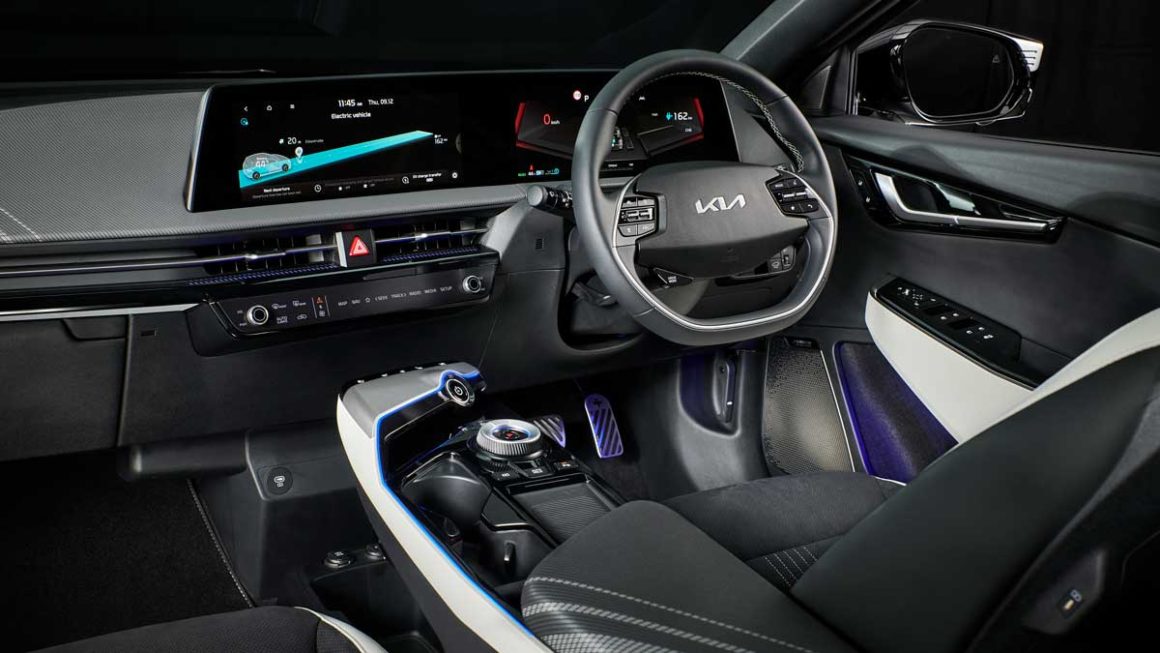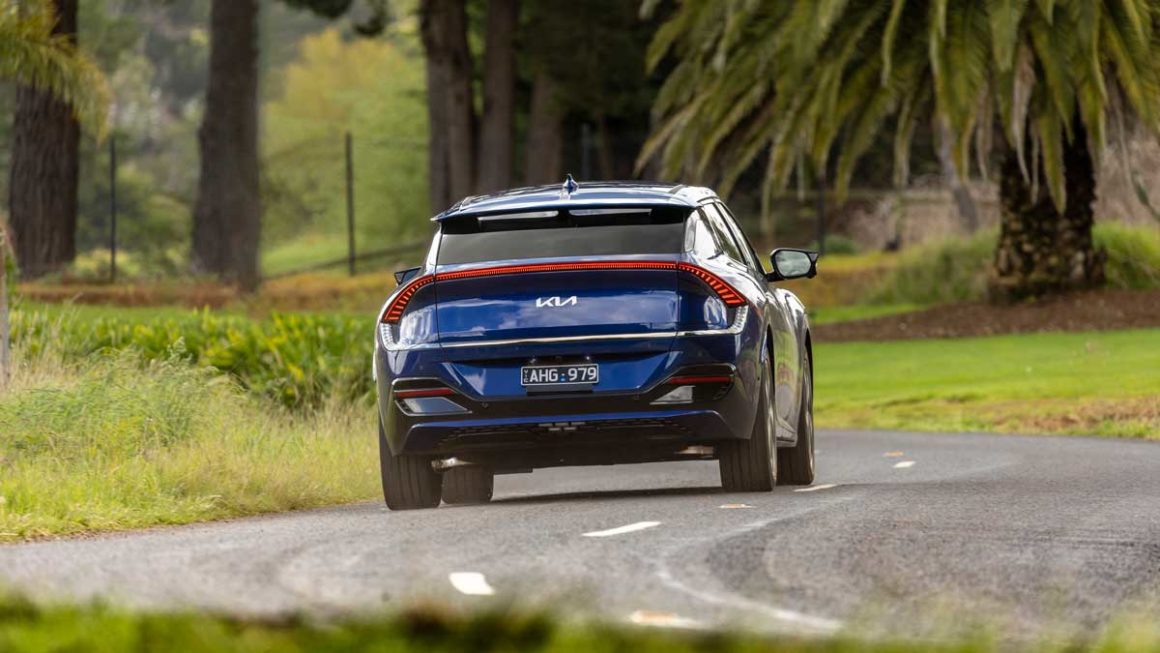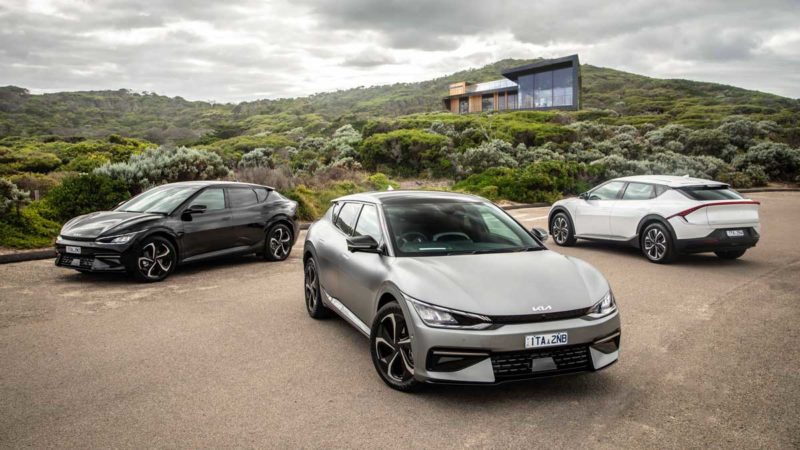The last time I found myself in the Brindabella Ranges to the west of Canberra was nearly half a century ago, armed with a compass and a map, a sandwich and a water bottle, in an orienteering event organised for the school camp. I’ve waited nearly 50 years to share the news: My friend Dougall and I came first!
This time though, there was no map and no compass. The food and drink came from a coffee cart powered by the “vehicle to load” facility of a Kia EV6, the newly released electric SUV.
The navigation was pre-ordained, and loaded up and digitally served for a media “drive impressions” event organised by Kia for the EV6, the first of a series of at least seven different models to be delivered on its new dedicated electric platform. And it wasn’t supposed to be a race.
It didn’t take long to realise why it was that we were driving along this particular route, all narrow and windy roads, with tight corners, big dips and sharp rises, through the hills to the west of Canberra. There’s a lot of things to like about the EV6, but its handling is probably the best feature of all. It is super impressive.
This is the first serious attempt by Kia to crack the EV market, and even they appear surprised by the response. The interest from customers – in terms of firm orders, expressions of interest and test drive requests – has outdone every other vehicle they have brought to Australia, including the popular fossil fuel sports sedan known as the Stinger.
Kia, as we report here, reckons it could sell 5,000 EV6s a year if it could get hold of enough cars, such is the level of demand. That would quickly propel the EV6 to the second best selling EV in Australia, behind only the Model 3.
But as it is, the global supply chain is being crunched by transport logistics and shortages of key components, and Australia ranks near the bottom of the world when it comes to the major car makers’ EV allocations, thanks in great part to the dumb-ass comments and regressive policies of the ruling federal Coalition government.
The end result is that there will only be around 500 EV6s brought into the country this year, and likely next year too, a similar supply blockage that has impacted the Hyundai Ioniq 5, the Polestar 2 and the Volvo XC40.
 Which means, just as the Australian EV market is poised for take off, with tens of thousands of customers prepared to make the shift to electric, they are facing lengthy and frustrating queues. Even the Tesla Model 3 has a seven-month waiting list, and there is no sign yet of the Model Y.
Which means, just as the Australian EV market is poised for take off, with tens of thousands of customers prepared to make the shift to electric, they are facing lengthy and frustrating queues. Even the Tesla Model 3 has a seven-month waiting list, and there is no sign yet of the Model Y.
Why is the EV6 so popular? The reality is that the legacy carmakers, having ignored EVs for so long and allowing Tesla to get the inside running, are now starting to produce seriously good electric cars, and in the shape that is most popular just now, SUVs.
They are not cheap – the good ones range from $60,000 to upwards of $80,000 in what I could guess you could call the “mid-range” for car prices. It’s not much comfort for people who don’t want to spend any more than $30,000 or $40,000 for a new car. But if this is your price range, quite frankly there is little point buying a fossil fuel engine to move around.
The Kia EV6 is built on the same EV platform – known as e-GMP – as the Hyundai Ioniq 5. They are sister companies, though, I am assured, fierce competitors.
Kia paints itself as the younger and funkier brand, and that explains the sportier lines of the EV6. And while Hyundai put interior space as its priority for the Ioniq 5, Kia has put its emphasis on driving performance, and went to the trouble of tuning the suspension to local conditions, something not done yet for the Ioniq 5.
Many features are the same. It’s hard to tell much difference between the display and the instrumentation in the dashboard. Both are clean, clear, attractive and useful. The EV6 has a more substantial middle console/armrest that doesn’t move back and forth like the Ioniq 5, but it is bigger and can store more stuff.

Both have vehicle-to-load capabilities, but once again Kia has gone the extra mile and ensured that Australian customers have access to an interior plug, located beneath the back-seat, with a child-proof lock, which would be useful for charging up devices such as laptops. That can operate as the car is moving.
The exterior plug, accessed through an adaptor (see pic above) that plugs into the charging port, requires the car to be switched off, and is what you will be using for your power tools, your campaign equipment, your coffee carts and, if you really need or want to, keep as many appliances as you want in your house in the case of a blackout.
And, with a 77.4kWh battery that, in theory, could be up to a week!
It is important to note that this is “vehicle-to-load” (V2L), and not vehicle-to-grid (V2G). There is no ability yet to interact or send power back to the grid with the EV6, but it is a mighty useful service. Pretty soon, I predict, just about every EV will come with V2L, and Volkswagen has already declared it will do so by the end of 2023, if they ever send their EVs over here.
On the media drive impressions trip, we got to try out all three models of the EV6 – the basic “Air”, the GT Line rear-wheel drive and the GT Line all-wheel drive.

The Air comes in at just under $68,000, which will allow you to sneak in a $3,000 rebate in three states, and stamp duty exemptions where they apply.
The Air differs from the other models most notably with 19″ wheels rather than 20″ wheels, no electric controls for the seats (which for a $68,000 car seems a bit cheap), and lower cost trim (cloth and artificial leather versus premium vegan leather).
The big missing link in the Air is the lack of the “exterior” V2L facility. Apparently, it’s due to “differentiation of trim offerings” and the facility has been disabled. It seems a cynical move to shift customers into the upper price bands. It has the interior plug, but that means opening a window or door to power things you want to use outside the car.
The GT Line RWD has all the goodies and comes in at $10 short of $75,000, while the GT Line AWD has the advantage of two motors, and a lot more torque and zip, a wide sunroof, and comes at just short of $83,000.
What’s the difference on the road? Not much really.
In city traffic and along highways you would hardly notice. On windy, hilly roads like the ones we drove on, the Air and the GT RWD are fine. They can do 0-100 in 7.3 seconds, which sounds slow compared to a Porsche Taycan or a Tesla Plaid, or even a Model 3 Performance, but is plenty fast enough for most people in just about every instance.

Sure, there were a couple of occasions, such as the start of a long hill, or emerging from a tight corner into a long sweeping rise, when a little extra torque would have been fun, but is it worth the extra money? If your thing is performance, then absolutely, go straight to GT AWD, you won’t be disappointed. But if it’s not, then the other options are just fine.
You also get slightly more range in the RWD models. Although range will come down to the driving mode you choose – Eco, Normal or Drive – and to how you drive.
As usual, there are a bunch of different “regen” (regeneration) modes to choose from and which are controlled by paddles behind the steering wheel.
They range from the barely perceptible level 1 all the way to “i-pedal”, which has so much grip when you release the accelerator pedal it invites the driver to use only one pedal, except in emergencies. That’s my favourite set up.
There’s a few other things worth noting about this car.

While the EV6 doesn’t match the Ioniq on interior space, it is perfectly roomy. The Kia folk were very keen to point out that its interior dimensions matched, or in some cases bettered, the Model Y, and the frunk (where the motors used to be under the bonnet) has plenty of space in the RWD versions, and the boot can fit three golf bags, if that’s your thing.
It can tow up to 1,600kg, although your range will be obviously reduced. It has a low co-efficient of drag (wind resistance) of 0.28, which is slightly better than both the Ioniq 5 and the I-Pace. And it weighs more than two tonnes, which despite its low centre of gravity and easy handling, is important to remember when you are throwing it around a corner.
It can charge at a rate of up to 350kW, if you can find a charger in Australia that actually works at that speed. There is a seven-year warranty, and if you are really desperate for some sort of noise to validate your movements, there are audio controls that can deliver a variety of artificial sounds. Not for me, thank you, I enjoy the silence.
All in all, it’s a very good package. The EVs being made now are high spec and high quality. They are fun to drive, and I think the vehicle-to-load capability is a great addition. It offers 3.6kW of power, which is more than enough for most appliances. Shame they scrimped on that on the Air version.
With the Ioniq, I got to boil a kettle and make a cup of tea. With the EV6, there was one there powering a coffee cart, making sure we didn’t go without a mid-morning latte. And it can power the appliances in your house in case of a blackout, or even another EV. I am looking forward to taking one home and using it to charge up my Tesla!
You can download the Kia EV6 spec sheet here.

Giles Parkinson is founder and editor of The Driven, and also edits and founded the Renew Economy and One Step Off The Grid web sites. He has been a journalist for nearly 40 years, is a former business and deputy editor of the Australian Financial Review, and owns a Tesla Model 3.


